Table of Contents
Introduction
Predictive Analytics Statistics: Predictive analytics relies on past data and statistical models to anticipate future developments or patterns.
It encompasses data gathering, model training, performance assessment, and real-time implementation. This approach has practical uses across industries like finance, healthcare, and marketing, including tasks like identifying fraud and predicting demand.
Ethical concerns, including safeguarding data and ensuring fairness, are crucial. Predictive analytics evolves alongside technological progress and the incorporation of big data and IoT, influencing its future direction.
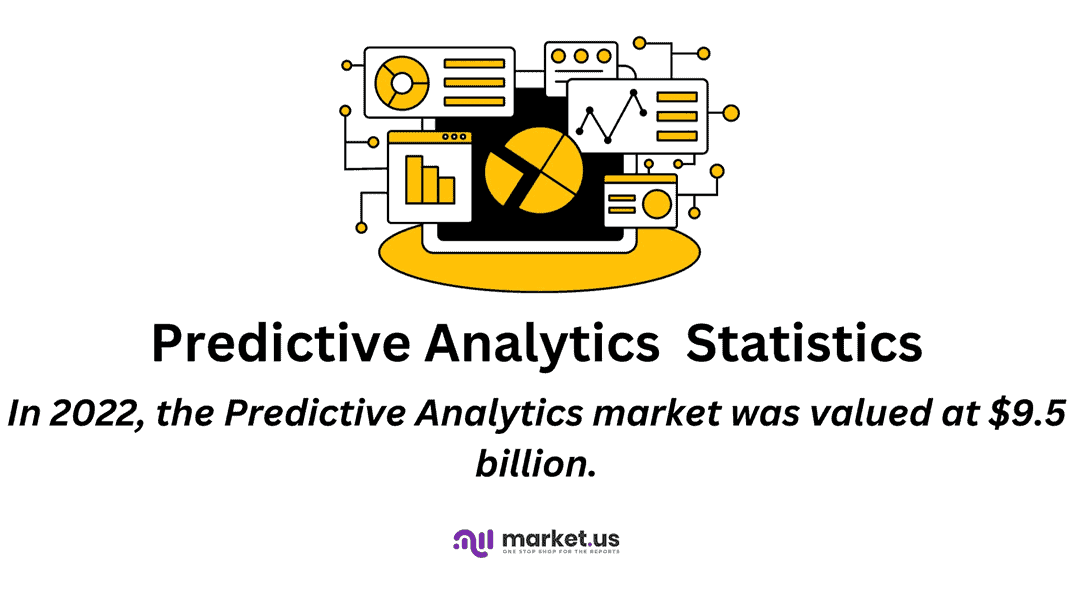
Editor’s Choice
- The predictive analytics market is poised for significant growth over the next decade at a CAGR of 21.2%, as indicated by the projected revenue figures.
- In 2022, the market was valued at $9.5 billion, and it is expected to steadily increase in the coming years.
- In 2023, the total market revenue is expected to jump to USD 11.5 billion. With solutions revenue remaining at USD 7.0 billion and services revenue holding steady at USD 4.0 billion.
- On-premises deployment holds a dominant position, representing the majority with a market share of 64%.
- In the year 2022, an impressive 72% of these leaders believed that predictive analytics would lead to enhancements in health outcomes. Suggesting that the ability to predict and prevent health issues could result in better patient health overall.
- In a survey conducted, 64% of respondents highlighted the improvement in efficiency and productivity as a key advantage of their endeavors.
- Foremost among these is the concern over data privacy and security. Which was cited by 49% of participants as a significant obstacle.
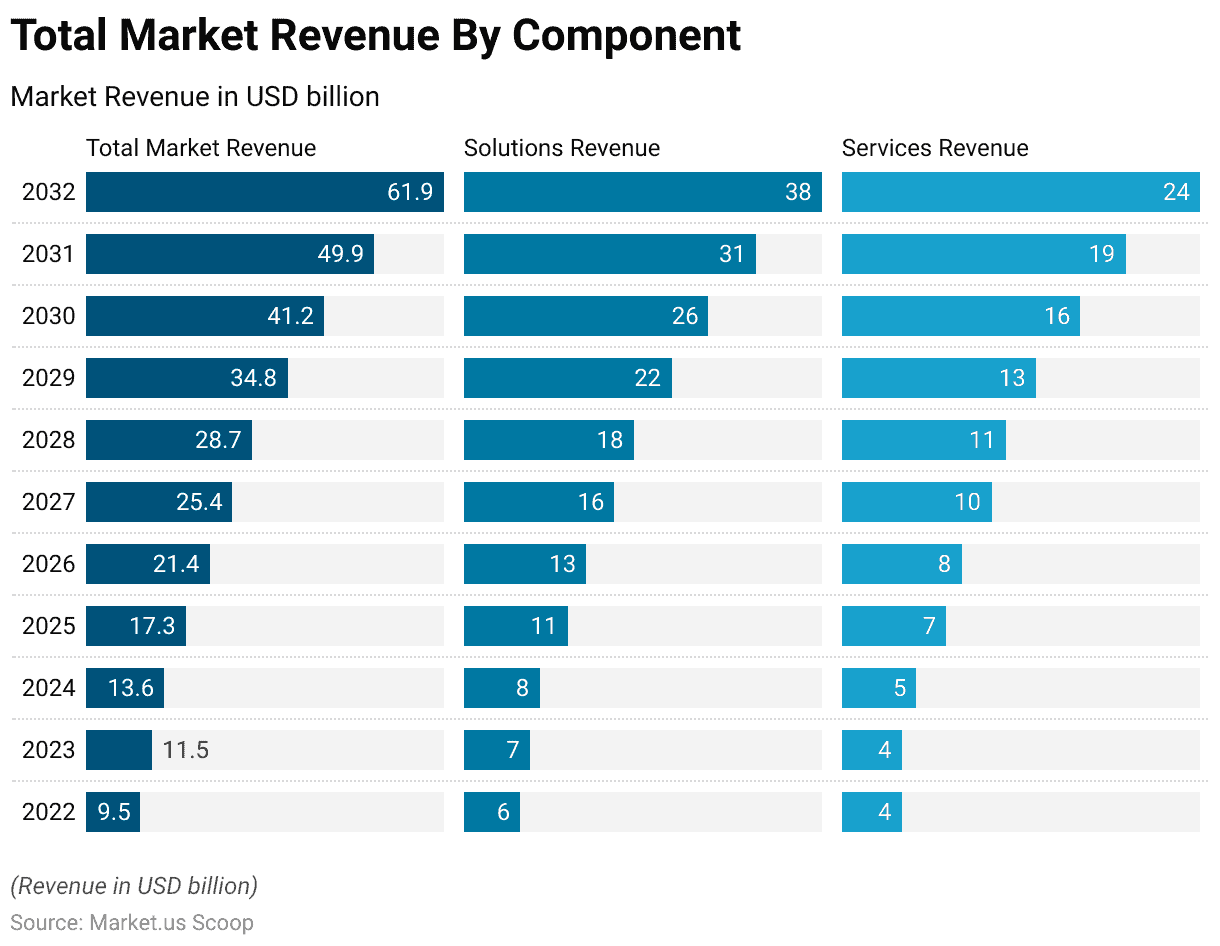
Global Predictive Analytics Market Statistics
Global Predictive Analytics Market Size Statistics
- The predictive analytics market is poised for significant growth over the next decade at a CAGR of 21.2%, as indicated by the projected revenue figures.
- In 2022, the market was valued at $9.5 billion, and it is expected to steadily increase in the coming years.
- By 2023, it is estimated to reach $11.5 billion, marking a notable uptick.
- This growth trend is anticipated to continue, with revenues projected to reach $13.6 billion in 2024 and further expand to $17.3 billion by 2025.
- The market is set to witness even more substantial expansion in the following years. With revenues of $21.4 billion in 2026 and $25.4 billion in 2027.
- By 2028, it is forecasted to exceed $28.7 billion, and the momentum is expected to persist. With revenue figures of $34.8 billion in 2029 and $41.2 billion in 2030.
- The predictive analytics market is projected to surpass the $49.9 billion mark in 2031 and continue its remarkable growth trajectory, reaching $61.9 billion in revenue by 2032.
- These impressive figures underscore the increasing importance of predictive analytics in various industries. Driven by advancements in data science and machine learning technologies.
(Source: Market.us)
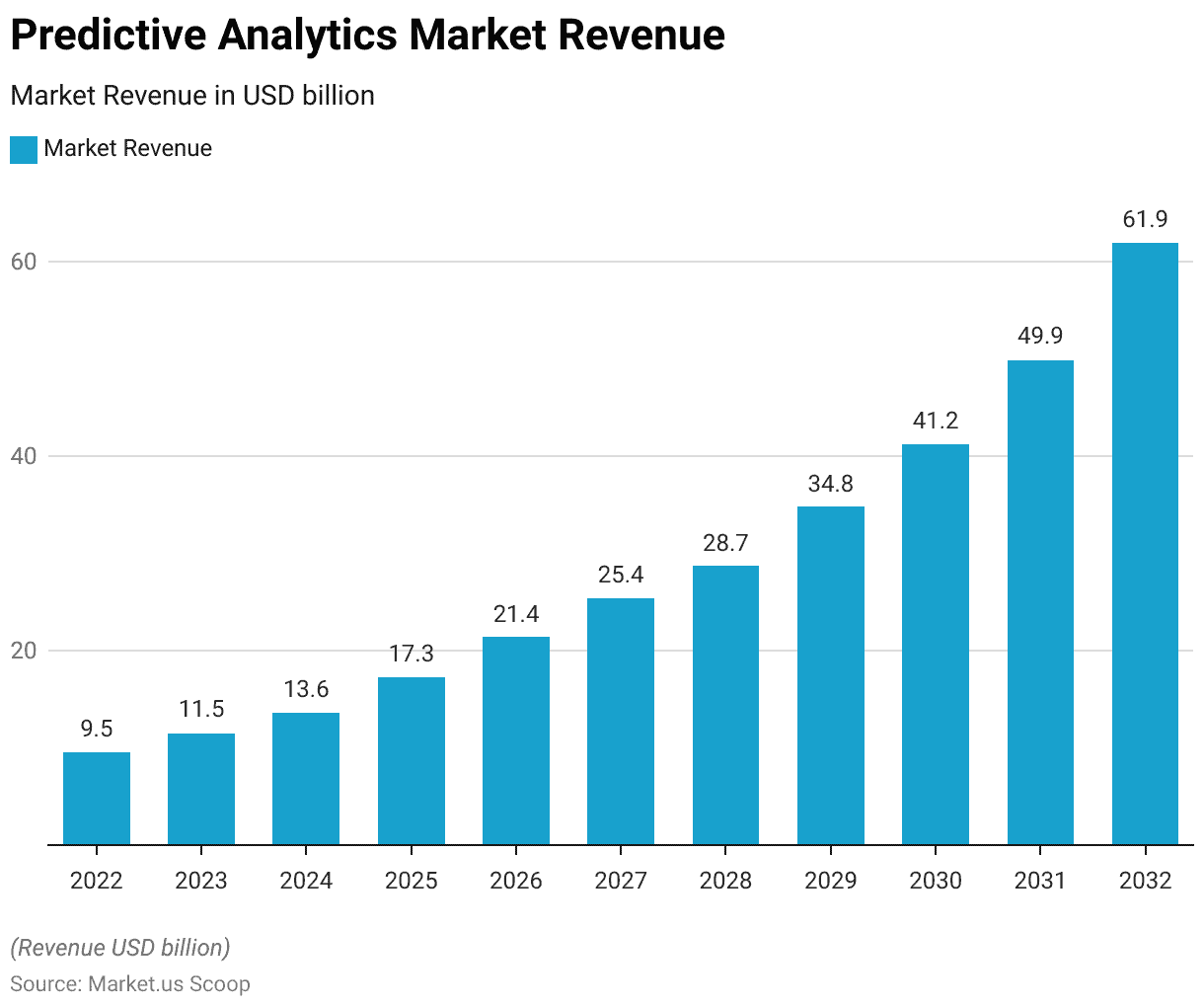
Predictive Analytics Market Size – By Component Statistics
- The global predictive analytics market is poised for substantial and sustained growth in the coming decade. With an upward trajectory that is expected to transform the landscape of data-driven decision-making across various industries.
- In 2022, the market exhibited promising figures, boasting a total revenue of USD 9.5 billion. This revenue was divided into two key components: solutions and services.
- Solutions, which encompass advanced analytical tools and software, accounted for USD 6.0 billion. While services, encompassing implementation, consulting, and management, contributed an additional USD 4.0 billion to the market’s revenue stream.
- As we look ahead to the future, the market is projected to experience robust expansion. In 2023, the total market revenue is expected to jump to USD 11.5 billion. With solutions revenue remaining at USD 7.0 billion and services revenue holding steady at USD 4.0 billion.
- The subsequent years continue to showcase impressive growth, with the market reaching USD 13.6 billion in 2024, USD 17.3 billion in 2025, and USD 21.4 billion in 2026.
- The driving force behind this growth is the increasing adoption of predictive analytics solutions by businesses across diverse sectors. These solutions enable organizations to harness the power of data to make informed and proactive decisions, optimize operations, and gain a competitive edge.
- As a result, the solutions segment is expected to see significant expansion. Reaching USD 38.0 billion in revenue by 2032, reflecting the growing demand for advanced data analytics tools.
- Moreover, the services segment is also set to experience steady growth, as businesses seek expert assistance. In implementing, customizing, and managing predictive analytics solutions to suit their specific needs.
- By 2032, services revenue is projected to reach USD 24.0 billion. Highlighting the integral role of specialized expertise in the successful deployment of predictive analytics.
(Source: Market.us)
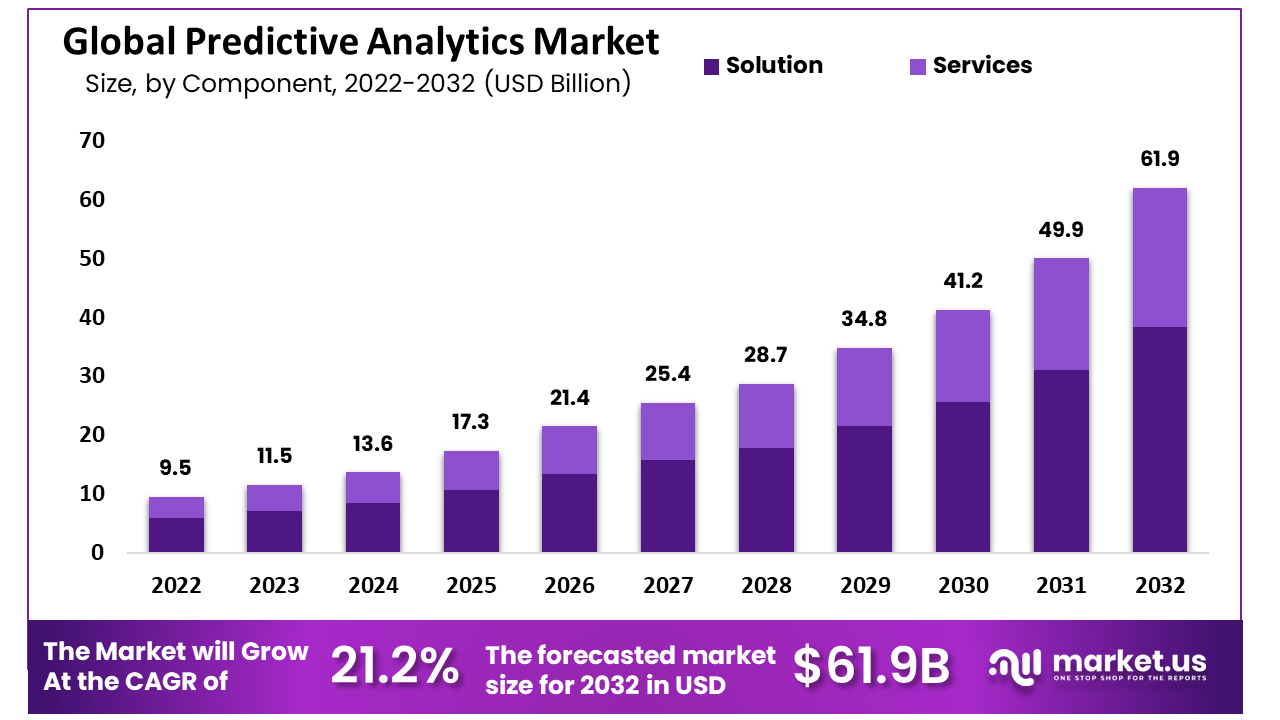
Global Predictive Analytics Market Share – By Deployment Mode Statistics
- In the global predictive analytics market, deployment modes play a crucial role in determining the landscape.
- On-premises deployment holds a dominant position, representing the majority with a market share of 64%.
- This traditional approach involves hosting predictive analytics solutions within an organization’s infrastructure, offering complete control over data and processes.
- In contrast, cloud-based deployment accounts for 36% of the market share, reflecting the growing popularity of cloud solutions.
- Cloud deployment provides scalability, flexibility, and cost-efficiency, making it an attractive choice for businesses seeking agility and reduced infrastructure overhead.
- This market distribution signifies the diverse preferences of organizations as they navigate between on-premises and cloud solutions based on their specific needs and objectives in the field of predictive analytics.
(Source: Market.us)
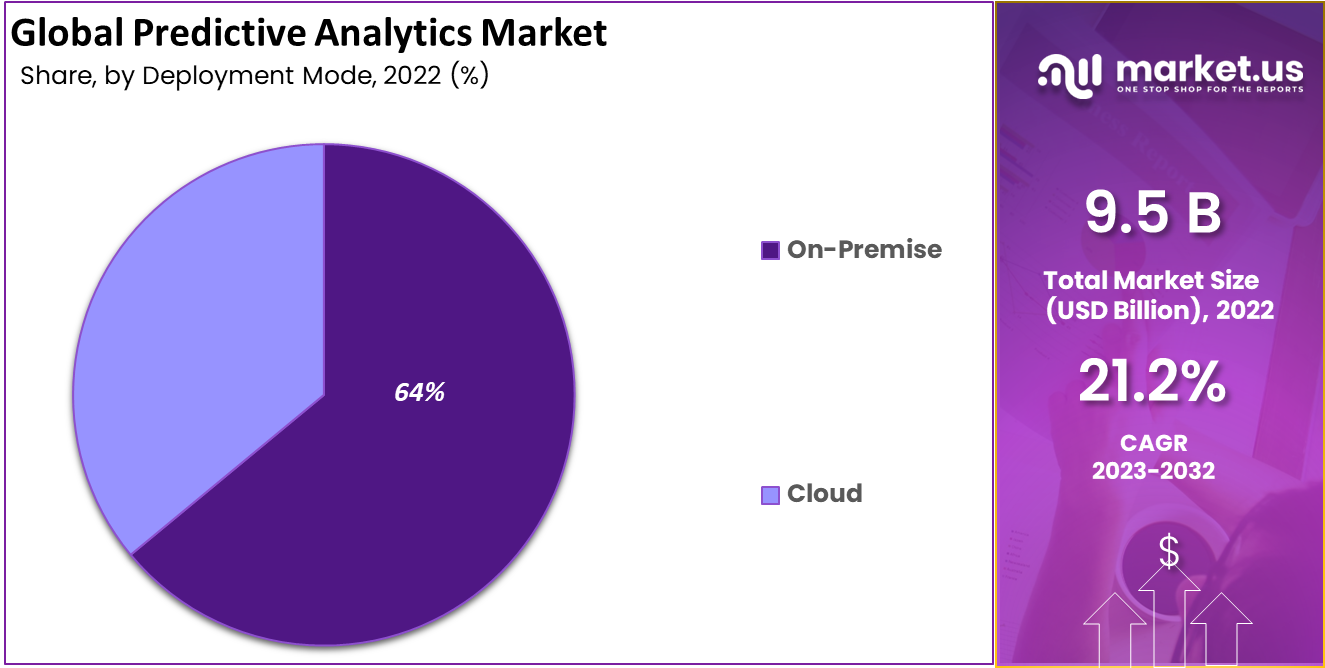
Useful Predictive Analytics Tools Statistics
SAP Analytics Cloud
- SAP is a major multinational software corporation originating from Germany in the 1970s.
- Their core expertise lies in Enterprise Resource Planning (ERP), and they offer a range of robust data platforms.
- SAP Predictive Analytics, once their primary data analytics tool, is now being integrated into SAP’s comprehensive Cloud Analytics platform.
- This broader platform goes beyond what SAP Predictive Analytics offers, with a stronger focus on Business Intelligence (BI). SAP Analytics Cloud utilizes AI to enhance business planning and forecasting, providing compatibility across all types of devices.
- Its scalability makes it suitable for businesses of all sizes. Augmented analytics is a feature that leverages Natural Language Processing (NLP) to extract valuable insights from large datasets.
- Machine learning plays a key role in automating workflows, consistently revealing valuable relationships and patterns.
- Importantly, SAP Analytics Cloud is designed for user-friendliness, making it accessible to individuals of all skill levels.
- For Business Intelligence, SAP Analytics Cloud starts at $22.00 per user per month.
(Source: SAP)
Take advantage of our unbeatable offer - buy now!

RapidMiner
- RapidMiner has its roots in the AI department of the Technical University of Dortmund and was established in 2006.
- Today, it offers two main products: RapidMiner Go and RapidMiner Studio.
- RapidMiner is a comprehensive data analysis platform that covers the entire data analysis process. It employs data modeling and machine learning techniques to provide robust predictive analytics.
- The platform is user-friendly, featuring a quick drag-and-drop interface. Users have access to a library containing more than 1,500 algorithms to apply to their data.
- There are also pre-designed templates available for tasks like monitoring customer churn and predictive maintenance.
- RapidMiner serves as an effective data visualization tool, making it simple to interpret future business outcomes. Additionally, automated machine learning provides valuable statistics on potential gains and other return-on-investment (ROI) data.
- RapidMiner Studio offers a free version, while the Professional version is priced at $7,500 per user per year, and the Enterprise version costs $15,000 per user per year.
- For RapidMiner Go, pricing starts at $10 per month.
(Source: RapidMiner)
Alteryx
- Formerly known as SRC LLC, Alteryx underwent a rebranding in 2010 and is now recognized as a leader in data science and machine learning according to Gartner’s Magic Quadrant.
- Alteryx’s primary offering is the APA platform, which stands for Analytic Process Automation.
- This platform seamlessly blends data science and predictive analytics, with a specific aim to make it accessible to non-coders.
- It provides a wide array of automation components, referred to as “building blocks,” that can be applied to your data.
- This transformation process turns large and complex data into practical and actionable insights. Alteryx is capable of handling unstructured data and can even perform sentiment analysis on raw data.
- Furthermore, Alteryx Analytics Hub simplifies the sharing of insights among teams and facilitates the creation of scheduled workflows, serving as a user-friendly automation builder.
- Alteryx offers various packages, with Alteryx Analytics Hub available at a rate of $72,000 per year.
(Source: Alteryx)
IBM SPSS
- IBM, short for International Business Machines, is a renowned technology company. Among its offerings is SPSS, a statistical solution introduced in 1968.
- SPSS specializes in advanced statistical analysis through two main modules: SPSS Statistics and SPSS Modeler.
- SPSS Statistics primarily focuses on predictive analytics, encompassing ad hoc analysis, hypothesis testing, and geospatial analysis for precise data insights.
- In contrast, the SPSS Modeler offers greater versatility, transforming predictive analysis into visual representations for pattern and anomaly detection.
- Additionally, users can utilize IBM’s Watson AI tool for advanced data science capabilities customized for predictive analytics.
- Pricing starts at $99 per user per month for IBM SPSS Statistics and $499 per user per month for IBM SPSS Modeler.
(Source: IBM SPSS)
TIBCO Spotfire
- TIBCO Spotfire offers a suite of tools designed for handling extensive datasets. When it comes to predictive analytics, it stands out for its user-friendly approach, making it accessible to all.
- Spotfire features “one-click predictions,” which are pre-programmed methods for data classification, clustering, relationship visualization, and forecasting.
- It excels in data visualization, providing real-time updates and the ability to create custom apps. Spotfire’s machine learning algorithms delve deep to yield comprehensive insights.
- TIBCO Spotfire offers a free version, with premium plans available at $25, $65, or $125 per month.
(Source: TIBCO)
H2O.ai
- H2O.ai, originating from Silicon Valley, is a notable open-source platform that serves a wide range of business intelligence needs.
- It has gained substantial recognition, with nearly half of Fortune 500 companies utilizing its products.
- H2O.ai offers a diverse set of products, leveraging the power of artificial intelligence and machine learning.
- Being open-source, it allows users to customize features to suit their specific requirements.
- Notably, H2O Driverless AI caters to data scientists, while H2O AutoML is designed for those without technical expertise.
- H2O also provides industry-specific templates, such as KYC and fraud prediction for finance, credit rating for insurance, and lead scoring and customer behavior prediction for marketing.
(Source: H2O.ai)
Benefits of Predictive Analytics in Healthcare Statistics
- In the year 2022, healthcare leaders across the globe displayed a high level of confidence in the potential of predictive analytics to bring about substantial improvements within clinical settings.
- Their responses shed light on the profound impact they anticipated in several key areas.
- Firstly, an impressive 72% of these leaders believed that predictive analytics would lead to enhancements in health outcomes, suggesting that the ability to predict and prevent health issues could result in better patient health overall.
- Similarly, another 72% expressed their optimism about the positive influence of predictive analytics on patient experience, emphasizing the importance of personalized and efficient healthcare delivery.
- Moreover, 70% expected improvements in staff experience, indicating that predictive analytics could streamline clinical processes, making them more manageable and effective for healthcare professionals.
- From a financial perspective, 69% of healthcare leaders foresaw a reduction in the cost of care, potentially resulting from the early identification of health issues, thus reducing the need for costly treatments.
- Additionally, 69% of respondents believed that predictive analytics would play a pivotal role in population health management, helping healthcare organizations better allocate resources and plan interventions.
- Addressing social concerns, 68% believed that predictive analytics could contribute to tackling health inequality, potentially by identifying disparities in healthcare access and outcomes, thus enabling targeted interventions to bridge these gaps.
- Lastly, 67% saw the potential of predictive analytics in advancing the adoption of value-based care practices, which prioritize the quality of care over the quantity of services provided.
(Source: Statista)

Benefits Companies Get from Using Analytics
- In a survey conducted, several notable benefits emerged from the responses of participants.
- A significant 64% of respondents highlighted the improvement in efficiency and productivity as a key advantage of their endeavors.
- Moreover, 56% emphasized the ability of predictive analytics to facilitate faster and more effective decision-making processes.
- Additionally, 51% acknowledged the positive impact on financial performance, showcasing the potential of predictive analytics to drive better fiscal outcomes.
- Beyond these financial aspects, 46% saw the potential for identifying and creating new revenue streams through innovative products and services.
- This finding aligns with the perspectives of another 46% who recognized the role of predictive analytics in enhancing both customer acquisition and retention efforts.
- Furthermore, 44% emphasized its contribution to improving customer experiences, underscoring its importance in delivering satisfaction and loyalty.
- Lastly, 43% highlighted the competitive advantage gained through the strategic use of predictive analytics, affirming its significance in staying ahead in a rapidly evolving business landscape.
(Source: MicroStrategy 2020)
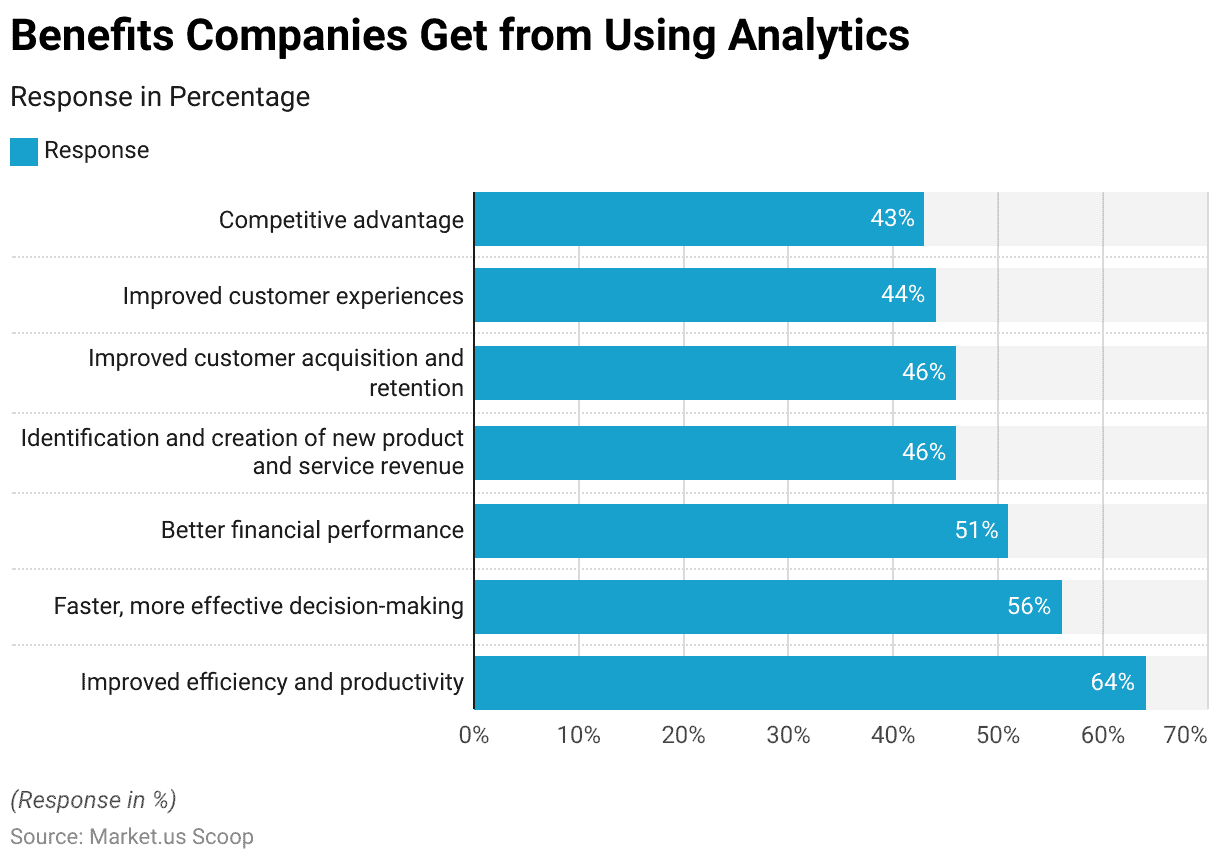
Barriers to the Effective Use of Analytics
- The effective utilization of analytics faces several notable barriers, as indicated by survey respondents.
- Foremost among these is the concern over data privacy and security, which was cited by 49% of participants as a significant obstacle.
- A substantial 33% highlighted the limitation in accessing data as a hindrance to effective analytics implementation.
- In addition, 29% pointed to a deficiency in training as a barrier, indicating a need for skill development.
- Furthermore, 28% expressed challenges with user-friendly solutions, emphasizing the importance of intuitive tools.
- Issues related to technology were also prevalent, with 26% citing a lack of proper technology and 24% indicating a deficiency in analytics technology within organizations.
- Other barriers included the absence of a centralized tool for data capture and analysis (21%) and a lack of executive focus on analytics use (20%).
- These barriers collectively underscore the multifaceted challenges organizations face in harnessing the full potential of analytics for informed decision-making.
(Source: MicroStrategy 2020)

Recent Developments
Acquisitions and Mergers:
- IBM acquires Databand.ai: In 2023, IBM acquired Databand.ai, a data observability startup, for $150 million. This acquisition enhances IBM’s data and predictive analytics capabilities by offering tools that monitor and ensure the reliability of predictive models in various industries.
- Oracle acquires DataScience.com: In 2023, Oracle completed the acquisition of DataScience.com, a company that provides data science tools and infrastructure for predictive analytics, for $250 million. This acquisition helps Oracle integrate data science and machine learning into its cloud offerings, improving predictive analytics solutions for enterprise clients.
New Product Launches:
- Microsoft launches Azure Predictive Analytics Service: In early 2024, Microsoft launched its new Azure Predictive Analytics Service, designed to simplify predictive model development by leveraging built-in AI tools. This service aims to help businesses of all sizes forecast trends, optimize operations, and make data-driven decisions with ease.
- Google Cloud introduces Vertex AI Forecasting: In late 2023, Google Cloud launched Vertex AI Forecasting, a tool that integrates machine learning models to improve business predictions and analytics. This product is targeted at industries like retail, finance, and supply chain management, helping them enhance their forecasting capabilities.
Funding:
- DataRobot raises $300 million for predictive analytics development: In 2023, DataRobot, a leader in AI-driven predictive analytics, secured $300 million in Series G funding to further develop its automated machine learning platform. The funding will be used to expand into new sectors like healthcare and financial services and improve predictive modeling.
- RapidMiner secures $50 million for AI-powered predictive analytics: In early 2024, RapidMiner, an open-source data science platform, raised $50 million in Series E funding. The company plans to use the investment to enhance its AI-driven predictive analytics features, focusing on automating model development and improving user accessibility.
Technological Advancements:
- AI and machine learning integration in predictive analytics: AI and machine learning are becoming critical in predictive analytics solutions. By 2025, over 55% of businesses are expected to adopt AI-powered predictive analytics tools to enhance decision-making and operational efficiency, particularly in areas like finance, marketing, and supply chain management.
- Automated predictive model development: Automation tools are simplifying predictive analytics by enabling users to build and deploy predictive models without advanced coding skills. By 2026, automated predictive analytics platforms are projected to account for 35% of market demand, as more businesses prioritize accessible and easy-to-use tools.
Conclusion
Predictive Analytics Statistics – Predictive analytics, a vital tool in data-driven decision-making, uses historical data and statistical methods to foresee future outcomes across various industries. It empowers organizations to make well-informed choices and gain a competitive edge.
To maximize its benefits, businesses need to address challenges like data access limitations and training gaps while ensuring data privacy and security.
As predictive analytics continues to advance, it promises to revolutionize operations and strategies, offering improved outcomes and a deeper understanding of complex data landscapes.
FAQs
Predictive analytics is a data analysis technique that uses historical data, statistical algorithms, and machine learning models to make predictions about future events or outcomes.
Predictive analytics works by analyzing historical data to identify patterns, relationships, and trends. Machine learning models are then trained on this data to make predictions based on new or unseen data.
Predictive analytics has a wide range of applications, including but not limited to forecasting sales, predicting customer churn, fraud detection, healthcare outcomes prediction, demand forecasting, and predictive maintenance in manufacturing.
Predictive analytics offers benefits such as improved decision-making, increased efficiency, cost savings, enhanced customer experiences, and the ability to proactively address issues before they arise.
Common techniques in predictive analytics include linear regression, decision trees, logistic regression, neural networks, time series analysis, and clustering.
Discuss your needs with our analyst
Please share your requirements with more details so our analyst can check if they can solve your problem(s)



